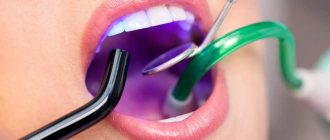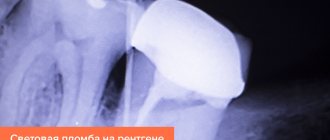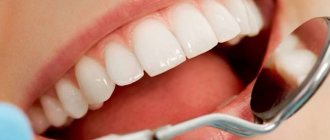Content:
- Types of light fillings
- Distinctive features of the coating
- What does dental photopolymer consist of?
- Indications for installation
- Pros and cons of photopolymer “tabs”
- How to install a light seal
- Use in pediatric dentistry
- How long do they serve?
To close a carious cavity and restore aesthetics and functionality to a tooth, dentists use different filling materials.
These compounds are constantly being improved to make them more reliable, durable and easier to use. Recently, doctors are increasingly placing light fillings. They have an acceptable cost and fit as tightly as possible to the walls of the unit. They can be used both in the treatment of caries and to eliminate chips and depressions resulting from traumatic injuries to the jaw.
The main feature of light-curing fillings is that they harden exclusively under the influence of a blue lamp. This allows specialists to carry out all treatment measures without unnecessary haste and as carefully as possible. After all, the risk that the material will harden ahead of time, when the surface of the crown to be filled has not yet acquired sufficient aesthetics, is completely absent.
What does the cost depend on?
- Manufacturer and country of manufacture of the polymer material.
- Degree of tooth decay: the most carious tooth needs more restoration.
- Clinic level.
- Material and equipment used.
- Tooth location (front ones will cost more, as they require more aesthetic work)
- Doctor's qualifications.
It is worth remembering that the installation of a filling is preceded by treatment, which, as a rule, is paid for separately. It includes anesthesia and canal cleaning.
Types of light fillings
The classification is based on the installation area. Teeth located in the smile zone require a more careful approach. Beauty comes to the fore during treatment. To solve this problem, doctors take a light-hardening material intended for application to the frontal zone. It consists of a finely dispersed light composite, that is, it includes small particles and has a complex composition.
There are reflective fillings for the chewing area. They contain larger light polymers, which allow the molars to chew food as actively as they did before treatment.
What manufacturers' fillings do we use?
- Charisma is a German material with the smallest particle size, a high degree of adherence and a smooth surface.
- Filtek is a composite of the American company 3M ESPE, has high strength, 35 shades, and is close in physical properties to tooth tissue.
- Estelite is a Japanese material, resistant to staining, bacteria, abrasion like natural teeth.
- Esthet-X is a composite from the DENTSPLY brand (USA/Switzerland), suitable for any restoration, characterized by resistance to chipping and durability.
Making an appointment does not oblige you to anything, you can cancel your appointment at any time
Make an appointment
Distinctive features of the coating
When talking about this dental material, it is necessary to emphasize that it:
- It hardens only when treated with a special medical lamp , while ordinary fillings become hard as a result of a chemical reaction that occurs between their components and oxygen from the air. The bonds formed during the processing of the liquid photopolymer composition are much stronger. This means that the light “tab” will exactly repeat the shape of the carious “hollow”. There will be no gaps or microcracks between it and the walls of the tooth in which microorganisms could multiply. All this together significantly extends the service life of the material.
- May be of different shades. Therefore, the dentist has the opportunity to make a destroyed fang, molar or incisor beautiful, almost indistinguishable from its neighbors. The ability to match colors is very important when working with front units.
What material is used
It is a light-curing composite that hardens when exposed to ultraviolet light. As a result of using this material, it turns out that the installed filling is light. In its original form, it is plastic, so the doctor can accurately copy the anatomical shape of the tooth, restoring its missing part. The composition includes heliocomposite, glass ceramics, stabilizers, and pigments that give a certain shade.
Advantages:
- Absolute safety and hypoallergenic.
- Non-toxic
- Withstands significant chewing load.
- Excellent polishability.
- They have the natural shine of healthy tooth enamel.
- Suitable for all patients.
Certain types of composite materials (for example, LuxaCore) contain zirconium dioxide, so we use them to fix intra-canal pins, which allow us to restore severely damaged teeth.
What does dental photopolymer consist of?
Light-curing filling composition includes:
- Heliocomposite. Used by dentists for direct dental restoration. New generation coating. Unable to freeze without a light source. It is absolutely harmless. It does not contain any impurities that could harm human health. Can be used without restrictions by pregnant and lactating women. Quite elastic. This means that during restoration activities, unwanted zoohardening will not occur. Under the influence of an ultraviolet lamp, heliocomposite decomposes into radicals. It is as a result of this process that the polymerization process of the filling is activated.
- Filler. It can be glass ceramics, silicon dioxide and other means. The structure, shade and area of application of the filling agent depend on the characteristics of the filler.
- Binding connections. Needed for reliable adhesion of all substances that form the light-hardening composition.
What are the approximate prices
- In Moscow, prices for installing a photopolymer filling vary greatly: from 1,850 to 8,000 rubles .
- In St. Petersburg, such tooth restoration will cost from 1 thousand to 3,500 rubles .
- In Khabarovsk, a light-curing filling costs 3,410 rubles .
- In Tula, installing such a seal costs 2 thousand rubles .
- In the Voronezh region, the cost of a light seal starts from 1,500 rubles .
Indications for installation
Dentists use light composite if:
- it is necessary to remove carious cavities of any size, including very large ones;
- unsightly stains have formed on the enamel that need to be “camouflaged”;
- as a result of the injury, a large chip appeared (at least 50% of the crown must be preserved);
- there are minor defects in the top layer - scratches, chips, cracks;
- you need to fill the “hole” in the neck of the tooth;
- it is necessary to fix the holding structure while bridging adjacent units.
This type of filling allows you to solve a variety of dental problems, ranging from aesthetic to functional. It is noteworthy that there are no absolute contraindications to the installation of light-curing material. The only limitation is an allergy to any coating compound. But most often you can choose an alternative.
Advantages and disadvantages of photopolymer fillings
Due to the peculiarities of the composition of composite photopolymer fillings, they have a whole range of advantages that make them the best material for restoring the function and aesthetics of teeth. The main advantages include:
- High quality of fixation on natural dental tissues - withstands strong mechanical loads and is resistant to temperature effects;
- Good plasticity – allows the doctor to effectively fill hard-to-reach areas of the teeth;
- Resistance to pigments – has increased resistance to various dyes, retains the original color for many years;
- Instant drying - the filling dries in a few seconds (under the influence of light rays of a certain spectrum);
- Aesthetic qualities - after treating the surface with special polishing attachments, a specific shine characteristic of natural tooth enamel is achieved.
This filling material has practically no disadvantages in comparison with analogues, with the exception of a higher cost. Therefore, before carrying out the procedure, it is worth checking with the doctor how much a light-curing filling costs in a particular case. Note! The price of a light-curing filling depends on a number of factors: the type of composite, its volume and the complexity of installation.
Pros and cons of photopolymer “tabs”
If we compare the light material with the usual one, the following advantages stand out:
- safe for health, does not contain toxic compounds;
- you can choose the desired shade and achieve impeccable aesthetics;
- after installation it is invisible to others;
- with proper care it lasts a very long time;
- is not an obstacle to further teeth whitening and grinding;
- very plastic, exactly repeats the shape of the recess;
- preserves the anatomical features of the tooth;
- allows you to eat and drink within half an hour after treatment;
- does not cause discomfort while wearing, absolutely imperceptible in the mouth.
Photopolymers also have disadvantages. So, they cannot be installed in hard-to-reach places. Their price is higher than a regular filling, which is also a disadvantage. For this reason, they are not used as a temporary “tab”.
Dentistry
Healthy teeth are not only about the beauty of your smile, but also about your health. After all, it is healthy teeth that allow a person to fully chew food, which has a beneficial effect on the functioning of internal organs, and also allows a person to fully experience the taste of food. A sick tooth can not only cause a lot of unpleasant sensations to a person, but is also fraught with consequences such as “infection” of neighboring teeth, bad breath, etc.
To avoid such unpleasant consequences, and also to be confident in the health of your own teeth, you need to regularly visit the dentist. Qualified and experienced specialists of the San-Van clinic will be able not only to give the necessary consultation and conduct a preventive examination, but also to carry out the necessary treatment. You shouldn’t skimp on your own smile, and even more so on your health, because these things in our lives are simply priceless.
DENTAL SERVICES
| Consultation | 0 rub. |
| Anesthesia Infiltration or conduction | 200 rub. |
| Fuji glass ionomer cement insulating gasket | 200 rub. |
| Medical pad | 100 rub. |
| Filling made of glass ionomer cement “Fuji” (Japan) | 600 rub. |
| Light seal 5th generation | 750 rub. |
| Light seal 6th generation | 900 rub. |
| Restoration (restoration of a destroyed crown) of the 1st tooth (6th generation light material) | 1700 rub. |
| Veneer coating of 1 tooth with 6th generation light material | 1500 rub. |
| Coating 1 tooth with fluoride varnish | 100 rub. |
| Coating with a product (desensitizer) (removing (reducing) the increased sensitivity of the 1st tooth) | 100 rub. |
| Pulp devitalization (arsenic) | 100 rub. |
| Trephination of the tooth crown | 100 rub. |
| Unsealing the 1st channel (Zn-oxide eugenol paste) | 300 rub. |
| ) Unsealing of the 1st channel (resorcinol-formalin paste | 400 rub. |
| Partial unsealing of the 1st channel | 300 rub. |
| Removing a foreign body from a canal of 1st degree of difficulty | 600 rub. |
| Removing a foreign body from a canal, level 2 of difficulty | 800 rub. |
| Removing a foreign body from a canal, level 3 of difficulty | 1000 rub. |
| Removing the anchor pin from the tooth | 500 rub. |
| Ultrasound treatment of 1 channel | 200 rub. |
| Temporary dressing with Endosolv, Largal | 200 rub. |
| Mechanical treatment of 1 obliterated canal | 200 rub. |
| Treatment of a 1-canal tooth (canal preparation and filling included) | 800 rub. |
| 2-canal tooth (canal preparation and filling included) | 1100 rub. |
| 3-channel tooth (canal preparation and filling included) | 1500 rub. |
| Treatment of 1 channel using ProTaper instruments | 1000 rub. |
| Temporary filling of the 1st channel | 200 rub. |
| Temporary filling | 100 rub. |
| Temporary filling "Septopack" | 200 rub. |
| Installation of the pin (Unimetric anchor) | 500 rub. |
| Installation of pin (fiberglass) | 700 rub. |
| Professional oral hygiene (removal of tartar, dark plaque, cigarette and coffee stains from 1 tooth) | 80 rub. |
| Medical treatment of periodontal pockets | 350 rub. |
| Application of a therapeutic bandage for periodontitis (one jaw) | 500 rub. |
| Fixation of decoration (rhinestones) on 1 tooth | 1000 rub. |
How to install a light seal
If you are about to have a light-curing filling installed, be prepared for the following steps:
- Removal of tissues affected by caries and necrotic areas. High-quality cleaning of the entire working surface.
- Antiseptic treatment of the formed bed.
- Placement of the liquid composition into the recess and its uniform distribution over the entire area.
- Bringing an ultraviolet lamp to the tooth.
- Grinding and polishing of the hardened base.
- Coating the restored tooth with dental varnish to protect it from the negative influence of external factors (temperature changes, mechanical damage, food coloring, etc.).
Light fillings are not made in a dental office. They come from the clinic in the form of syringes, inside of which there is a ready-to-use composition. The doctor simply squeezes the required amount of material into the damaged tooth.
What is a light or reflective seal?
Light filling is a polymer composite used for filling teeth. Its main feature is the ability to harden under the influence of a special ultraviolet lamp. The curing time is short - 1.5 - 2 minutes, depending on the thickness of the filling. To prevent injury to dentin by a sharp increase in mechanical pressure in the tooth cavity, filling is performed in stages, applying and drying the material layer by layer.
The light filling on the front tooth must be completely identical to the shade of natural enamel, therefore matching the color of the dentition is an important stage of filling. The advantages of reflective fillings are obvious:
- high strength;
- absence of harmful components;
- excellent aesthetic characteristics;
- long service life - from 5 years or more;
- ease of modeling.
A light filling is placed on a baby tooth. The material is well distributed inside the prepared cavity, penetrates into any, even the most inaccessible, recesses, preventing the spread of caries and the development of complications.
How long do they serve?
The minimum lifespan of light polymer is five to seven years, but with proper dental care it can be extended for several more decades. Theoretically, a well-installed photopolymer can last a lifetime.
Caring for a filled tooth is quite simple. It needs to be cleaned morning and evening, just like everyone else. Particular attention should be paid to the correct selection of brush and paste.
What products should you be careful with?
How soon can you eat after installing a reflective filling? There is no definite answer. But regarding the food consumed, experts agree. Thus, it is recommended to exclude coloring products for 2–3 days after a light filling. Ingestion of foods, including drinks, containing dyes may affect the color of the composite, since the filling is still highly permeable.
After restoring teeth with a light filling, it is better to avoid the following foods for at least two days:
- coffee;
- beet;
- carrot;
- blueberry;
- carbonated drinks;
- chocolate and cocoa.
In small quantities you can use:
- black tea;
- strawberry;
- cherries;
- natural juices.
Dentists pay special attention not only to when and what not to eat with a light filling, but also to the temperature of the food eaten. You should not eat too hot or cold foods, or eat them one after another or together. The temperature contrast can lead not only to damage to the filling, but also to damage to the tissues of a healthy and diseased tooth.








